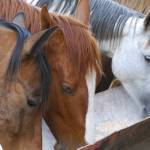What Happens to Excess Phosphorus in a Horse’s Diet?

Students of equine nutrition have a mantra regarding calcium and phosphorus levels in diets, such as “not less than 1 to 1 for calcium to phosphorus.” But what happens when diets stray from convention? What happens to that extra phosphorus? Does it impact bone health, is it simply excreted in urine or feces, or does it build up elsewhere in the body?
“One hypothesis is that excess phosphorus in a horse’s diet is stored in bone in the form of hydroxyapatite crystals that help make bone rigid and strong,” explains Kathleen Crandell, Ph.D., equine nutritionist at Kentucky Equine Research in Versailles, Ky.
Calcium and phosphorus both play important roles in many body functions, including musculoskeletal health. Not only is the balance between the two minerals important but also the total daily amounts that are fed.
Crandell adds, “The amount of calcium and phosphorus in different feedstuffs can be highly variable, which means that horses might not be getting either the correct amount or balance of minerals.”
To better determine what happens if phosphorus is fed in higher amounts than currently recommended by the National Research Council, an international group of equine researchers* fed three different diets to horses over a 42-day period: a diet with recommended calcium and phosphorus levels, a diet high in both calcium and phosphorus, and a diet high only in phosphorus. They then measured various markers of bone turnover and parathyroid hormone levels, which can indicate if excess phosphorus is being stored in bone and therefore retained in the body.
Key findings were that:
- Ponies fed the control diet (with recommended calcium and phosphorus levels) had a zero phosphorus and calcium balance, meaning that neither mineral was stored in the body;
- Both calcium and phosphorus were retained when fed a diet with higher than recommended amounts of the minerals;
- Calcium was not retained, but phosphorus was, when ponies were fed diets high in phosphorus;
- Magnesium, another important mineral in equine health, had reduced absorption when ponies were fed a high-phosphorus diet; and
- There were increased phosphorus levels in urine when ponies were fed a high-phosphorus diet but not when fed a diet high in both calcium and phosphorus, suggesting that calcium and phosphorus form insoluble complexes.
Perhaps most importantly, this study showed that excess dietary phosphorus does not alter bone metabolism or impact parathyroid hormone levels (involved in bone metabolism). It is, however, possible that inappropriate ratios and amounts of minerals can induce the formation of insoluble mineral complexes of calcium, phosphorus, and magnesium in the intestines, called enteroliths, which can cause colic.
“Prolonged overfeeding of phosphorus can cause big-head disease or secondary hyperparathyroidism, and two ponies included in the study were beginning to show signs of the disease by the end of the study period. This study suggests that horses appear to be able to tolerate high levels of phosphorus for a short period of time, which can happen when first-cut hay has a reversed ratio of calcium to phosphorus, and that’s good news,” notes Crandell.
*Van Doorn, D.A., F.J.W.C. Schaafstra, H. Wouterse, et al. 2014. Repeated measurement of P retention in ponies fed rations with various Ca:P ratios. Journal of Animal Science 92:4981–90.








